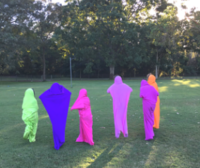 Sensory Integration
Sensory Integration
Sensory Integration is how the brain processes all the sensory input from the surrounding environment. Once our sensory integration processing is fully developed it enables us to concentrate on someone talking to us whilst there is traffic noise outside or whilst we are sitting in an uncomfortable chair or even sitting off balance. It also determines whether we can stay balanced while riding a bicycle as well as how we coordinate watching a soccer ball and then being able to kick it toward a goal.
Disturbances in our ability to process all this information can seriously affect how we cope with our day to day life. The treatment of Sensory Integration disorders was developed by the Occupational Therapist Jean Ayres. According to Ayres some people have difficulty in sending the information from our senses to our brain and processing this ready for the appropriate responses. As an example, many children with Attention Deficit Hyperactivity Disorder (ADHD) have a compromised Sensory Integration System, they have difficulty concentrating, relaxing, sitting still or holding focus. They can feel a general physical or psychological restlessness.
Our Senses
We have more senses than the tradition Sight, Sound, Taste, Smell, and Touch. In addition to these senses we have Vestibular Sense which is our balance and our sense of how and where we are in space, this sense starts developing already in the womb. Proprioception (Kinesthesia)is our sense of the positions and movement of different parts of our body, this is primarily sensed by our joints and muscles but also must coordinate with the Vestibular sense. The Tactile sense comes from our skin surface, mucous membranes and deeper in our muscles. Lastly there is also Visceral Input, which comes from the receptors of our internal organs.
Position and Movement (Proprioceptive Senses)
The Proprioceptive Sense is involved in coordinating how our muscles and joints should react. This is the sense that can coordinate us to kick the soccer ball to the goal, our hand eye coordination. If we are unable to process this sense correctly then the reactions can be clumsy or unbalanced. The deeper pressure perceived from the weight of the chains helps to stimulate the proprioception to calm and gives a better sense of the body. It forms a screen between the person and the over-stimulation from the surroundings enabling better concentration and a sensory calm.
Visceral Input
Vestibular Sense
Our Vestibular Sense involves gravity, head movement and balance. In the inner ear there is a complex structure of bones that contain the auditory receptors and two types of vestibular receptors. One type responds to gravity and the other sense changes in direction or speed. These cells are forming just 9 weeks after conception and respond to the mothers movement. This sense is already well developed by the time of birth and influences the ability to integrate information from the other senses.
Tactile Sense
Our Tactile Sense (or sense of touch) is stimulated by the chains of the chain blanket, first by the sensation on the skin from the chains through the fabric and secondly by deeper pressure. This helps to give a more secure feeling and better awareness of and connection to our own body. If you press the chains against the body then the brain will still be receiving stimulation from this message for a further 20 minutes. This is long enough for the brain to focus on the body instead of all the surroundings and so enables the user to fall asleep.











